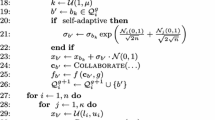Abstract
For an efficient competitive coevolutionary algorithm, it is important that competing populations be capable of maintaining a coevolutionary balance and hence, continuing evolutionary arms race to increase the levels of complexity. We propose a competitive coevolutionary algorithm that combines the strategies of neighborhood-based evolution, entry fee exchange tournament competition (EFE-TC) and localized elitism. An emphasis is placed on analyzing the effects of these strategies on the performance of competitive coevolutionary algorithms. We have tested the proposed algorithm with two adversarial problems: sorting network and Nim game problems that have different characteristics. The experimental results show that the interacting effects of the strategies appear to promote a balanced evolution between host and parasite populations, which naturally leads them to keep on evolutionary arms race. Consequently, the proposed algorithm provides good quality solutions with a little computation time.
Similar content being viewed by others
References
J.R. Koza, Genetic Programming: On the Programming of Computers by Means of Natural selection, The MIT Press: Massachusetts, 1992.
C.D. Rosin, “Coevolutionary search among adversaries,” Ph.D. dissertation, University of California, San Diego, 1997.
J. Paredis, “Coevolutionary computation,” Artificial Life, vol. 2, pp. 355-375, 1995.
C.D. Rosin and R.K. Belew, “New methods for competitive coevolution,” Evolutionary Computation, vol. 5, pp. 1-29, 1997.
S. Nolfi and D. Floreano, “Coevolving predator and prey robots: Do 'Arms Races' arise in artificial evolution?” Artificial Life, vol. 4, pp. 311-335, 1998.
W.D. Hillis, “Co-evolving parasites improves simulated evolution as an optimization procedure,” Physica D, vol. 42, pp. 228-234, 1990.
K. Sims, ”Evolving 3D morphology and behavior by competition,” in Proceedings of the 4th Artificial Life Conference, Massachusetts, 1994, pp. 28-39.
H. Juillé, “Evolution of non-deterministic incremental algorithms as a new approach for search in state spaces,” in Proceedings of the 6th International Conference on Genetic Algorithms, Pittsburgh, 1995, pp. 351-358.
H.J.C. Barbosa, “Agenetic algorithm for min-max problems,” in Proceedings of the 1st International Conference on Evolutionary Computation and its Applications, Moscow, 1996, pp. 99-109.
L. Pagie and P. Hogeweg, “Evolutionary consequences of coevolving targets,” Evolutionary Computation, vol. 5, pp. 401-418, 1998.
J. Paredis, “Coevolution, memory and balance,” in Proceedings of the 16th International Joint Conference on Artificial Intelligence, Stockholm, 1999, pp. 1212-1217.
J.Y. Kim, Y.K. Kim, and Y. Kim, “Tournament competition and its merits for coevolutionary algorithms,” Journal of Heuristics, vol. 9, pp. 249-268, 2003.
B. Olsson, “Optimization using a host-parasite model with variable-size distributed populations,” in IEEE 3rd International Conference on Evolutionary Computation, Nagoya, 1996, pp. 295-299.
P.J. Angeline and J.B. Pollack, “Competitive environments evolve better solutions for complex tasks,” in Proceedings of the 5th International Conference on Genetic Algorithms, San Mateo, 1993, pp. 264-270.
R.E. Smith, S. Forrest, and A.S. Perelson, “Searching for diverse, cooperative populations with genetic algorithms,” Evolutionary Computation, vol. 1, pp. 127-149, 1993.
J.H. Holland, “Adaptive algorithms for discovering and using general patterns in growing knowledge-bases,” International Journal of Policy Analysis and Information Systems, vol. 4, pp. 245-268, 1980.
J.H. Holland, “Properties of the bucket brigade,” in Proceedings of the 1st International Conference on Genetic Algorithms, Hillsdale, 1985, pp. 1-7.
D. Cliff and G. Miller, “Tracking the red queen: Measurements of adaptive progress in co-evolutionary simulations,” in The 3rd European Conference on Artificial Life, Strany, 1995, pp. 200-218
J.B. Pollack and A. Blair, “Co-evolution in the successful learning of backgammon strategy,” Machine Learning, vol. 32, pp. 225-240, 1998.
H. Juillé and J.B. Pollack, “Coevolutionay learning: A case study,” in Proceedings of the 15th International Conference on Machine Learning, San Francisco, 1998, pp. 251-259.
D.B. Fogel, Evolutionary Computation: Toward a New Philosophy of Machine Intelligence, IEEE Press: New York, 2000.
S. Forrest, B. Javornik, R.E. Smith, and A.S. Perelson, “Using genetic algorithms to explore pattern recognition in the immune system,” Evolutionary Computation, vol. 1, pp. 191-211, 1993.
Rights and permissions
About this article
Cite this article
Kim, Y.K., Kim, J.Y. & Kim, Y. A Tournament-Based Competitive Coevolutionary Algorithm. Applied Intelligence 20, 267–281 (2004). https://doi.org/10.1023/B:APIN.0000021418.72362.fb
Issue Date:
DOI: https://doi.org/10.1023/B:APIN.0000021418.72362.fb




